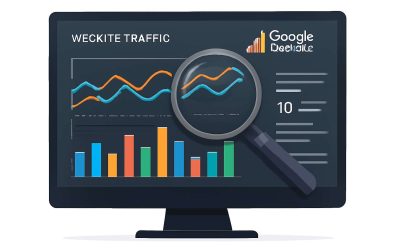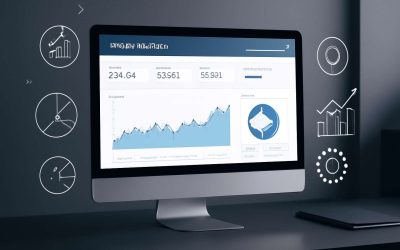Understanding Website Traffic
What is Website Traffic?
In the bustling realm of digital presence, understanding website traffic is akin to reading the pulse of your online audience. It’s the lifeblood that reveals who visits your site, how they arrive, and what keeps them lingering. As the saying goes, “What gets measured gets managed,” and nowhere is this more true than in the realm of SEO. When pondering, “can I see website traffic?” the answer hinges on the tools and insights at your disposal.
Website traffic encompasses all the visitors that navigate through your online domain—whether they stumble upon your site via search engines, social media, or direct links. This data isn’t just numbers; it’s a window into visitor behavior, preferences, and engagement levels. For those eager to decipher their digital footprints, understanding these metrics is the first step toward refining their online strategy.
- Traffic sources—where visitors come from.
- Visitor behavior—what pages they visit and how long they stay.
- Conversion rates—whether visitors take desired actions.
With the right analytics, it becomes possible to answer, “can i see website traffic,” with clarity and precision, transforming raw data into actionable insights that elevate your SEO game. After all, in the competitive landscape of South Africa’s digital market, knowing your traffic is knowing your future.

Why Monitoring Website Traffic Matters
Gazing into the digital horizon, understanding website traffic is like unlocking a treasure chest of possibilities. It’s the secret map to discovering who your visitors are, what draws them in, and how they navigate your online realm. When pondering, “can i see website traffic,” the answer is a resounding yes—if you have the right tools and insights. These tools don’t just display numbers; they reveal stories waiting to be told.
Monitoring website traffic illuminates the pathways that lead visitors to your site and the routes they take once they arrive. By examining traffic sources—whether through search engines, social media, or direct visits—you begin to see the bigger picture of your digital ecosystem. This understanding helps you tailor your SEO strategies and enhance user experience, ultimately boosting engagement and conversions.
For those navigating the South African digital landscape, recognizing the importance of these metrics is vital. The ability to see website traffic transforms abstract data into a vivid narrative, guiding your next move with confidence and clarity. So yes, when you ask, “can i see website traffic,” the answer is yes—if you’re equipped to read the signs and follow the trail.
Types of Website Traffic
Understanding website traffic isn’t just about crunching numbers; it’s about deciphering a digital DNA that reveals your audience’s every move. When you ask, “can i see website traffic,” you’re opening the door to a treasure trove of insights. But not all traffic is created equal. There are different types, each telling a different story about your online presence.
Organic traffic, for instance, comes from search engines like Google—your loyal fans who find you through keywords and queries. Paid traffic results from advertising efforts, bringing visitors who are often already primed to convert. Then there’s referral traffic, coming from links on other websites, acting like digital word-of-mouth. Lastly, direct traffic is your loyal base typing your URL straight into their browser, a sign of brand recognition and loyalty.
Knowing how to distinguish these traffic types helps target your SEO efforts more effectively. For example, if organic traffic is lagging, it might be time to revisit your keyword strategy. Meanwhile, referral traffic can highlight influential partnerships or content that resonates. Essentially, when pondering, “can i see website traffic,” the answer is yes—if you know which traffic types to look for and how they weave into your overall SEO narrative.
Methods to Track Website Traffic
Using Web Analytics Tools
Peering into the digital shadows to answer the question, can I see website traffic, is a game-changer for anyone serious about their online presence. Web analytics tools act like digital seers, revealing hidden patterns and behaviors that fuel business growth. With these tools, you gain access to detailed insights—where visitors come from, what pages captivate them, and how long they linger. The real magic lies in their ability to transform raw numbers into actionable intelligence.
One of the most powerful methods to see website traffic in action is through platforms like Google Analytics, which offers a comprehensive dashboard filled with real-time data. You can track visitor demographics, device usage, and referral sources. To streamline your analysis, consider setting up custom reports or alerts that notify you of sudden traffic spikes or drops, giving you a supernatural edge over competitors. The question can I see website traffic becomes less mysterious when you harness these tools effectively.
Server Log Analysis
Peering into the digital shadows to answer the question, can i see website traffic, often requires more than just surface-level observations. Server log analysis acts as an ancient yet ever-reliable spell, capturing every visitor’s whisper as they traverse your virtual corridors. Through meticulous examination of these logs, you can uncover precisely when traffic surges or wanes, all while revealing the elusive pathways that lead visitors to your site.
Unlike dashboards that display a filtered view, server log analysis dives deep into raw data—offering an unfiltered glimpse into visitor behavior. This method provides invaluable insights into the technical health of your website and uncovers traffic sources that might otherwise remain hidden. For instance, you might discover a sudden increase in traffic from a specific referral source or identify patterns in user engagement that help refine your SEO strategy.
To make the most of server log analysis, consider employing tools that automate the parsing of these logs. Here is a simple approach:
- Extract relevant data points such as IP addresses, timestamps, and requested URLs
- Analyze for recurring referral patterns or unusual spikes
- Cross-reference with your analytics platform for a comprehensive understanding
Through this enchanted process, the question of can i see website traffic transforms from a mystery into a strategic advantage, revealing the unseen currents guiding your digital voyage.
Integration with Advertising Platforms
In the shadowy corridors of the digital realm, a question lingers like a whisper in the darkness—can I see website traffic? Integrating with advertising platforms offers a clandestine window into this mystery, allowing you to trace the ghostly footprints of visitors who pass through your virtual domain. By linking your website with platforms like Google Ads or social media advertising tools, you unlock a portal that reveals how audiences engage with your content in real time.
This integration is more than mere voyeurism; it’s a strategic ritual. It enables you to discern which campaigns summon the most visitors, which keywords beckon the most traffic, and where the unseen currents of referral traffic flow from. To harness this power, some practitioners employ
- conversion tracking
- UTM parameters
—an arcane method that tags your links with mystical markers, illuminating the path visitors take before arriving at your site.
In this dance of shadows and signals, the question of can i see website traffic transforms from an elusive enigma into a potent instrument—guiding your digital voyage through the labyrinth of unseen visitors and traffic sources, revealing secrets buried deep within the web’s eternal night.
Can You See Website Traffic Yourself?
Accessing Analytics Data
Imagine peering into an enchanted crystal ball that reveals the bustling activity on your website—an intriguing question lingers: can I see website traffic myself? The answer is a resounding yes! With the right tools, you can unlock a treasure trove of insights without needing to summon a digital sorcerer. Web analytics platforms like Google Analytics are designed to be accessible, offering a window into user behaviour, page views, and visitor origins. These tools empower even the most novice explorers to navigate the labyrinth of website traffic with confidence.
Accessing this data is often as simple as logging into a dashboard that feels like a map of your website’s universe. You can observe real-time visits, track popular content, and understand where your visitors are coming from—be it across South Africa or beyond. While some platforms can be complex, many are user-friendly, making it possible for you to see website traffic in a way that feels intuitive and engaging. The ability to monitor your website’s pulse is invaluable, transforming raw numbers into stories of growth and opportunity.
Getting Traffic Reports
Imagine holding a key to your digital kingdom—an enchanted window into the heartbeat of your website. The question echoes through the corridors of every online venture: can I see website traffic myself? The answer is an emphatic yes! With a sprinkle of curiosity and the right tools, you can unlock detailed traffic reports that reveal who visits your site, what they seek, and how often they arrive. No need for mystical spells—web analytics platforms like Google Analytics make this process surprisingly straightforward.
By simply logging into a user-friendly dashboard, you gain immediate insight into your website’s pulse. You can observe real-time visits, identify your most captivating content, and see where your visitors are coming from—whether they’re tuning in from Johannesburg or Johannesburg’s neighboring towns. These tools are designed with accessibility in mind, transforming complex data into an intuitive story of your online presence. So, yes, you can see website traffic—your digital crystal ball is within reach, revealing invaluable insights to steer your growth with confidence.
Understanding Data Metrics
In the shadowed corridors of the digital realm, the question lingers like a whisper in the midnight air: can I see website traffic myself? The allure of this knowledge is undeniable—unlocking the secrets behind every visitor, every click, every fleeting moment on your site. The truth is, with the right tools, this is no longer a question of mysticism but of method. Web analytics platforms, like Google Analytics, serve as your lantern in the darkness, illuminating the unseen movements of your audience.
Gazing into your website’s traffic data reveals more than mere numbers—it uncovers stories woven into the digital fabric. You can observe real-time visits, discover which pages captivate your visitors, and understand their origins—whether they arrive from distant Johannesburg or nearby towns. These insights are accessible through intuitive dashboards that transform complex metrics into clear, actionable revelations. So, yes, you can see website traffic—your digital crystal ball is within reach.
Legal and Privacy Considerations
User Privacy Laws
In the shadowy corridors of digital inquiry, one question echoes with haunting persistence: can I see website traffic? As we peer into the abyss of data, the allure of understanding visitor patterns tempts us with secrets long hidden behind encrypted veils. Yet, amid this pursuit, lurks a shadowy realm of legal and privacy considerations—an intricate dance between curiosity and compliance.
South African user privacy laws, much like ancient guardians, demand respect for personal boundaries. They bind website owners to a solemn vow: safeguard the identities of visitors while extracting the insights they seek. Violating these statutes can lead to dire consequences, tarnishing a reputation as easily as a shadow marred by the moon’s faint glow.
To navigate this darkness, consider these principles:
- Transparency about data collection
- Securing explicit consent from visitors
- Ensuring data is stored and processed lawfully
In this gothic dance of data and discretion, the question remains—when peering into the web’s unseen currents, one must always ask: can I see website traffic without crossing forbidden lines? The answer lies not just in the tools but in the sacred respect for privacy that binds us all.
Data Sharing Restrictions
In the realm of digital exploration, the question persists: can I see website traffic without trespassing into forbidden territory? The answer hinges on understanding the delicate balance between data access and respecting user privacy. South African laws, much like vigilant guardians, demand that website owners tread carefully to avoid infringing on personal boundaries. These regulations are not merely bureaucratic hurdles; they embody a sacred vow to protect visitor identities while still gleaning valuable insights.
Data sharing restrictions are at the heart of this ethical dance. Laws often restrict how and when website traffic data can be shared or used, especially if it involves personally identifiable information. To comply, website operators must ensure that their data collection methods are transparent and lawful. This includes securing explicit consent from visitors and implementing secure storage protocols. When these principles are met, the question of whether you can see website traffic becomes less a matter of capability and more an act of responsible stewardship. Remember, in this enchanted world of digital analytics, respecting privacy is the true key to unlocking the secrets of web traffic without crossing forbidden lines.
Interpreting Website Traffic Data
Key Metrics to Watch
Understanding the intricate dance of digital presence hinges on a profound grasp of website traffic data. When posed with the question, can I see website traffic, the answer extends beyond mere numbers—it’s about deciphering the silent stories embedded within each click, scroll, and bounce. Key metrics such as bounce rate, session duration, and page views serve as vital signs, revealing user engagement levels that often escape superficial analysis.
Interpreting these metrics demands a nuanced perspective; they are the heartbeat of your online ecosystem, pulsating with insights into user behavior and content resonance. For instance, a sudden spike in traffic coupled with a high bounce rate might signal that visitors arrive but quickly depart—prompting a deeper investigation into content relevance or site usability. Recognizing these subtleties can turn raw data into actionable intelligence, elevating your digital strategy to new heights.

Ultimately, the question of can I see website traffic is more than a technical inquiry—it’s an invitation to explore the complex psychological landscape of your audience. By honing in on specific data points and understanding their deeper implications, you unlock the potential to craft experiences that resonate on a visceral level, fostering loyalty and growth in a competitive digital arena.
Identifying Traffic Sources
Peering into the depths of your website’s activity reveals more than just numbers; it uncovers the hidden stories behind every visitor. When considering can i see website traffic, it’s essential to go beyond surface-level data and interpret the origins of your traffic sources. These sources paint a vivid picture of where your audience is coming from and how they find your digital space. Are they arriving via search engines, social media platforms, or direct visits? Each source carries a different story, impacting your overall strategy.
To truly understand your audience’s journey, focus on identifying traffic sources. This can be achieved through careful analysis of referral data and campaign tracking. For example, a sudden influx of visitors from social media might indicate a viral campaign, while a rise in organic search traffic suggests stronger SEO performance. Recognizing these patterns allows you to fine-tune your content and marketing efforts, ensuring that every click aligns with your goals. The question of can i see website traffic becomes an invitation to explore the nuanced pathways leading users to your website, unlocking insights that can transform your digital approach.
Analyzing User Behavior
Interpreting website traffic data is akin to deciphering the secret language of your digital visitors. It’s not just about knowing how many showed up; it’s about understanding what they did once they arrived. Analyzing user behavior reveals whether your visitors are casually browsing or genuinely engaged—an essential insight for anyone asking, can I see website traffic? When you explore metrics like bounce rates, session duration, and page views, you start to see the story unfold behind each click.
For example, if a significant portion of traffic lingers on your product pages, it indicates genuine interest—ideal for boosting conversions. Conversely, a high bounce rate might suggest your content isn’t meeting visitor expectations. Recognizing these patterns allows you to tailor your content and marketing strategies accordingly. Remember, every visitor’s journey is a narrative, and understanding these behaviors transforms raw data into powerful storytelling. In essence, analyzing user behavior is the key to unlocking the true potential of your website’s traffic—proving once and for all that, yes, you can see website traffic—and make it work for your business.
Enhancing Website Traffic Visibility
Optimizing SEO for Better Traffic Reports
Understanding how to see website traffic isn’t merely a technical exercise; it’s a strategic vantage point that reveals the pulse of your digital presence. When you ask, “Can I see website traffic?” you’re opening the door to a universe of insights that can transform your online endeavors.
Optimizing SEO isn’t just about keywords and backlinks; it’s about creating a seamless flow of information that makes your website irresistible to both users and search engines. Improving your visibility in traffic reports allows you to gauge the effectiveness of your content and marketing efforts more precisely. By leveraging advanced analytics tools, you can delve into granular data, uncovering patterns and behaviors that inform smarter decision-making.
The pursuit of better traffic visibility isn’t static—it’s a continuous process of refinement that can dramatically elevate your website’s reach and impact.
Using Third-party Tools for Competitive Analysis
In the intricate dance of digital visibility, understanding whether you can see website traffic isn’t just a matter of curiosity—it’s a strategic imperative. Third-party tools have revolutionized how businesses in South Africa and beyond enhance their website traffic visibility, transforming raw data into competitive advantages. These tools serve as digital magnifying glasses, revealing patterns and insights that might otherwise remain hidden.
By leveraging advanced analytics platforms, you gain access to granular data that paints a vivid picture of your online landscape. For example, tools like SEMrush, SimilarWeb, and Alexa can provide comprehensive competitive analysis, showing you where your traffic originates and how it stacks up against rivals. These insights empower you to refine your content strategy, identify new opportunities, and ultimately answer the question: can I see website traffic? with clarity and confidence.
- Identify key traffic sources and understand their impact.
- Analyze visitor engagement to refine user experience.
- Benchmark against competitors to spot gaps and opportunities.
Implementing Tracking Pixels and Tags
Understanding whether you can see website traffic is a game-changer for any digital strategy. Implementing tracking pixels and tags is a straightforward yet powerful way to increase visibility into your online performance. These small snippets of code, when embedded into your website, serve as digital sentinels, collecting vital data on visitor behavior and source attribution.
With the right setup, you can uncover detailed insights about your audience. For example, tracking pixels from platforms like Facebook or Google Analytics provide real-time data on where visitors come from and how they engage with your site. This transparency allows you to measure the impact of your marketing efforts accurately.
- Place tracking pixels across key pages to monitor user flow
- Configure tags to segment traffic by source, device, or location
- Review collected data regularly to refine your SEO and content strategies
Overall, integrating these tools helps answer the core question: can I see website traffic? and ensures you’re never in the dark about your digital footprint. The clarity gained can be the difference between stagnation and growth in today’s competitive online landscape.



0 Comments